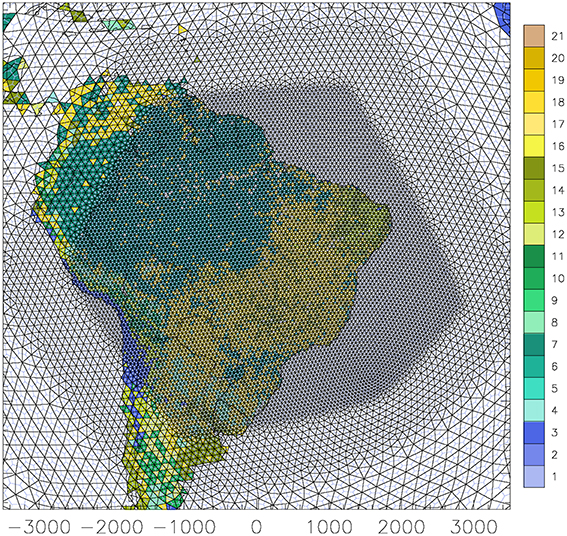Ocean Global Warming Impacts on the South America Climate
- Climate and Meteorology Laboratory, Department of Physics, Federal University of Santa Catarina, Florianópolis, SC, Brazil
The global Ocean-Land-Atmosphere Model (OLAM) model was used to estimate the impacts of the global oceanic warming on the climate projections for the 21st Century focusing on the South America region. This new model is able to represent simultaneously the global and regional scales using a refining grid approach for the region of interest. First, the model was run for a 31-year control period consisting on the years 1960–1990 using the monthly Sea Surface Temperature (SST) from the Atmospheric Model Inter-comparison Project (AMIP) data as a driver for the ocean fluxes. Then, the model was run for the period 2010–2100 using the monthly projected SST from the Hadley Center model (HadCM3) as a driver for the oceanic changes. The model was set up with an icosahedral triangular global grid having about 250 km of grid spacing and with a refining grid resolution with the cells reaching about 32 km over the South America region. The results show an overall temperature increase mainly over the center of the Amazon basin caused by the increase of the greenhouse effect of the water vapor; a decrease on precipitation mainly over the northeast Brazil and an increase in the south and over the western Amazon region; and a major increase on the near surface wind speed. These results are similar to the global coupled models (GCMs); however, OLAM has a novel type of grid that can provide the interaction between the global and regional scales simultaneously.
Introduction
The major efforts to stablish future climate scenarios are based on global coupled models (GCMs). A series of ongoing numerical integrations of climate models are now taking place at several research centers. The latest Intergovernmental Panel on Climate Change (IPCC) report (IPCC, 2013) produced climate change projections for near-term (Kirtman et al., 2013) and long-term (Collins et al., 2013) based on the Coupled Model Inter-comparison Project Phase 5 (CMIP5; Taylor et al., 2012).
For the South America region the majority of those GCMs show an overall increase of the near surface temperature, a decrease on the precipitation over the northeast region of Brazil, and an increase over the south of South America region (Collins et al., 2013; Kirtman et al., 2013).
The major climate variabilities over the South America are caused by the neighboring oceans (i.e., the Atlantic and the Pacific oceans). Near the equator gradients of temperature and pressure are the main forcing for the Hadley Cell formation (Lindzen and Nigam, 1987). Anomalies on the Atlantic SST and the trade winds can cause changes on the Hadley Cell strength (Servain et al., 2014), position (Wang, 2002; Xie and Carton, 2004) and advection of moisture and heat (Foltz et al., 2003) that produces variabilities on the moisture transport over the South America (Nobre and Shukla, 1996; Rao et al., 2006; Bombardi and Carvalho, 2011; Bombardi et al., 2014). Otherwise, during El Niño or La Ninã conditions on the Pacific the air-sea interactions can produce shifts on the position of the Intertropical Convergence Zone (ITCZ) and the Walker Cell causing extreme changes on the South America precipitation (Grimm, 2003; Kucharski et al., 2008); more specifically during El Niño climate analysis shows drier years over the northeast Brazil and higher precipitation over the south (Ropelewski and Halpert, 1987; Marengo and Hastenrath, 1993).
The majority of the global models have spatial resolution on the order of 0.5° to 4° and therefore do not resolve the regional meteorological features of South America forced by the complex surface heterogeneity and topography (Taylor et al., 2012).
To better resolve the regional climate the dynamic downscaling approach became an important resource. The dynamic downscaling method is characterized by the use of a higher spatial resolution regional climate model (RCM). A special project using RCMs is under development to provide dynamic downscaling of regional climate projections (Giorgi and Gutowski, 2015). While these models have higher spatial resolution for a given domain, they need atmosphere initial and lateral boundary conditions from a coarser global model. These RCMs have a one-way coupling with the GCMs and therefore the local changes do not affect the large scale.
A new approach was developed recently in order to provide a two-way coupling through the use of a global model with varying spatial resolution. One of these new type of models is the Ocean-Land-Atmosphere Model (OLAM) (Walko and Avissar, 2008a,b). This new model is able to represent simultaneously the global and the local atmospheric features through a grid refining approach.
Up to now, climate projections were conducted with global models that have low resolution, or with regional climate models that are dependent of a particular global model for boundary conditions. For the first time, we can use a new type of model such as OLAM that can do a global spatial coverage and resolve simultaneously the local meteorological systems using its refining grids. In this study we used OLAM to provide numerical simulations for the current climate and for the 21st century in order to evaluate the impacts of the global ocean warming on the climate projections for the South America region and try to answer the following: “What is the expected regional climate change caused by the projected oceanic global warming?; how these projected climate changes compares with results from other previous modeling estimates?; can OLAM provide a more refined regional climate projection as compared with the GCMs?”
Data and Methods
In the next sub-sections we describe the OLAM model, the numerical experiments design and the data used as initial and surface boundary condition.
The OLAM Model
The OLAM model is an evolution of the Regional Atmospheric Modeling System (RAMS) model (Cotton et al., 2003) and uses a global icosahedral type of grid that can be triangular or hexagonal (Walko and Avissar, 2008a,b). The Navier-Stokes equations are solved on the global grid using the finite volume technique that maintains the conservation of mass, momentum and energy.
A series of recent studies showed that OLAM is able to simulate well the major weather systems (Ramos-da-Silva et al., 2014) and regional climate of the South America region (Medvigy et al., 2012, 2010). Furthermore, the model was used to understand the effects of the El Niño South Oscillation (ENSO) phenomena in the South America and the results showed that an spatial resolution over the Andes mountains have to be greater than 100 km to fully represent the effects of the ENSO on the climate of the Amazon region. Thus, since OLAM had shown a good skill for the South America local meteorological features, it can be used as a tool to evaluate the climate projections as impacted by expected oceanic warming.
The physical parametrizations options for OLAM are the same available at the RAMS model including the land-vegetation interaction (Walko et al., 2000a), the cloud microphysics (Walko et al., 1995, 2000b; Meyers et al., 1997), the radiation transfer (Chen and Cotton, 1987) and cumulus parametrization (Grell, 1993, 2002; Kain, 2004). The RAMS mesoscale model was used in several applications for the South America studies such as on the deforestation impacts (Gandu et al., 2004; Ramos da Silva et al., 2008); lightning formation (Gonçalves et al., 2012), convection transport (Freitas et al., 2000), and weather forecasting (Ramos da Silva et al., 2007; Longo et al., 2013). Therefore, the physical parameterizations have been very well-tested on several different systems for the South America region.
The Model Experiments Setup
In order to estimate the projected regional climate changes caused by the global oceanic warming, the OLAM model was set with a global icosahedral triangular mesh having about 250 km of grid spacing between cells. A nesting refinement approach was applied with focus over South America region with the innermost domain having a 32 km of grid spacing (Figure 1). This refining grid approach allows a two-way interaction between the large and the local scales. In the vertical direction the model was set with 45 atmospheric layers having about 200 m in the lowest layer and 2000 m in the upper stratospheric layers. For these spatial sizes the model had a time step of 30 s to maintain numerical stability.
The chosen physical parameterizations included the short and long-wave radiation transfer (Chen and Cotton, 1987), the cumulus parametrization (Grell, 1993), the soil-vegetation model (Walko et al., 2000a), the cloud microphysics (Meyers et al., 1997; Walko et al., 2000b, 1995), and the turbulent atmospheric fluxes parametrization (Smagorinsky, 1963).
Initially, the model was run for the period 1960–1990 to produce a climatological control run. The initial atmospheric conditions for geo-potential height, winds, air temperature, relative humidity, and soil moisture were obtained from the National Center for Environmental Prediction (NCEP) Reanalysis Project (Kanamitsu et al., 2002). This initial condition was set only for the onset of the integration because the model is global and the lateral nudging is not necessary. In this climatological simulation the oceanic conditions were updated based on the monthly observed SST data provided by the Atmospheric Model Intercomparison Project (AMIP) as described by (Taylor et al., 2000).
The Twenty-one century simulation was run for 2010–2100 having the same configuration of the control run but using monthly SST boundary projections from the Hadley Centre Coupled Model, version 3 (HadCM3; Gordon et al., 2000; Collins et al., 2001) from its A1B scenario. This A1B projection assume that the anthropogenic emissions of CO2, CH4, N2O and sulfur-di-oxide based on a future world of very rapid economic growth and population that peaks by 2050 and declines thereafter based on more efficient technologies (IPCC, 2007).
The climate projections for the South America was produced by taking the difference between the mean field results for the periods 2011–2040, 2041–2070, and 2071–2100 and the results from the climatological run (i.e., 1960–1990).
Monthly precipitation data from the Global Precipitation Climatology Project (GPCP) was used to evaluate the model results for the 1960–1990 climatological run (Adler et al., 2003).
Results
The GPCP observed accumulated precipitation data shows that while the Amazon region has the highest precipitation, the northeast region of Brazil has a very low accumulation (Figure 2A). Over the Amazon basin the model underestimated the precipitation as compared to the maps of GPCP observations (Figure 2B). For the climatological period (i.e., 1960–1990) there is only sparse pluviometric observed data over the region and the fields are obtained from extrapolations. Also, It seems that the differences between the model and the observations occurs over the Amazon River basin, thus although the model uses a 32 km of grid spacing, it may not be able to fully represent the squall lines that are the main precipitating meteorological system of this region (Cohen et al., 1995). Although, the model underestimates the total accumulation it represents the main spatial observed pattern (Figure 2B). Therefore, these results from the model can be used as a control run and the projected regional climate changes can be estimated through comparisons with the new runs for the 21st century.
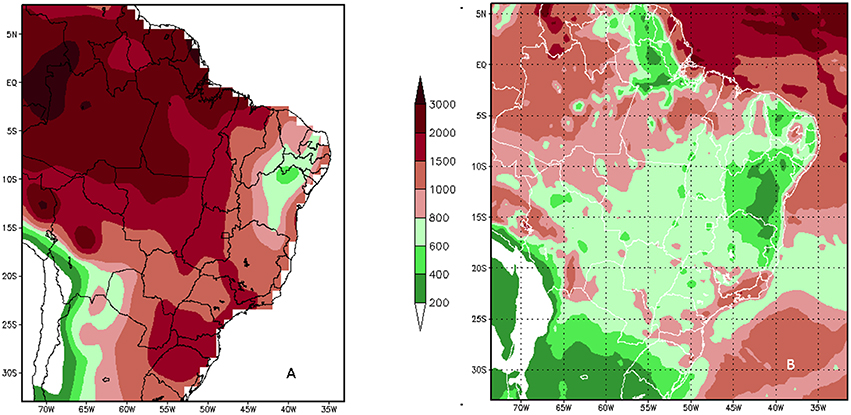
Figure 2. Accumulated precipitation (mm/yr) for the period 1960–1990 from (A) GPCP observations and (B) simulated by the OLAM model.
Near Surface Temperature Changes
Figure 3 shows the results for the projected temperature change for 2011–2040. The results show increase over most of the north region, mainly over the Amazon region that can reach temperature increases higher than 4°C (around longitude 50 W); while a slight decrease is projected over the south of the domain. This warming over the Amazon was obtained also in other studies (Blázquez et al., 2012; Marengo et al., 2012) but here, the projected increase of temperature in this region is higher. For the period 2041–2070 the temperature increase reaches a larger domain with the highest increase occurring over the Amazon (Figure 4). For the period 2071–2100 the warming is spread for the entire continental domain reaching the highest increase over the Amazon region in the order of 6°C (Figure 5). The major reason for this increase in temperature is due to the enhancement of the greenhouse effect of the water vapor. This greenhouse effect strength is shown by the increase in the downward long wave radiation at the surface that is higher over the tropical regions (Figure 6). The maximum increase of downward long wave radiation, greater than 60 Wm−2, occurs at the same location. Thus, although the anthropogenic greenhouse gases trend were not considered on the OLAM regional climate projections, the greenhouse effect was enhanced by the feedback of the water vapor produced by the ocean warming.
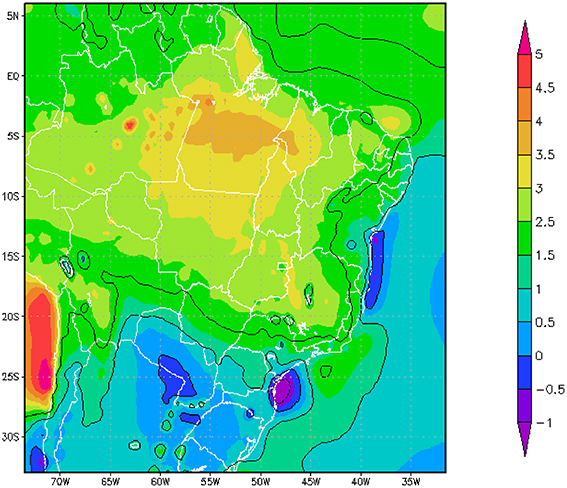
Figure 3. Projected Surface Air Temperature changes (°C) for 2011–2040 relative to the climatological run (1960–1990).
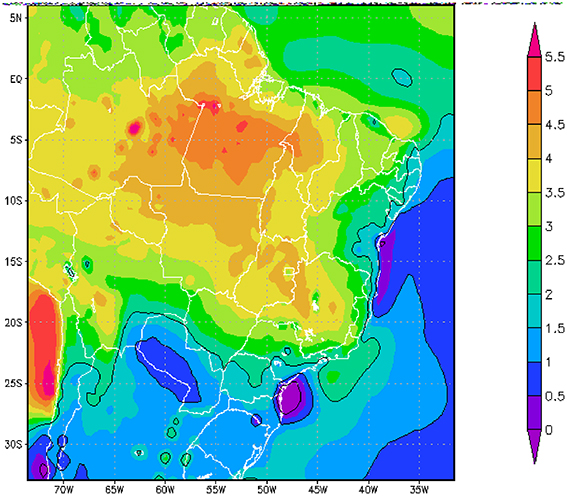
Figure 4. Same as Figure 3, but for temperature changes (°C) on the period between 2041 and 2070.
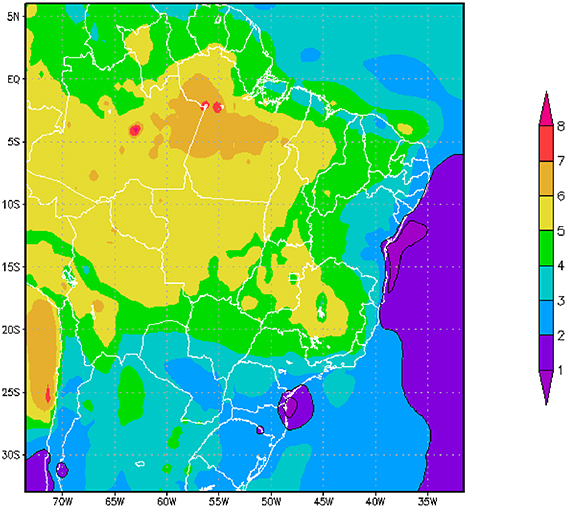
Figure 5. Same as Figure 3, but for temperature changes (°C) on the period between 2071 and 2100.
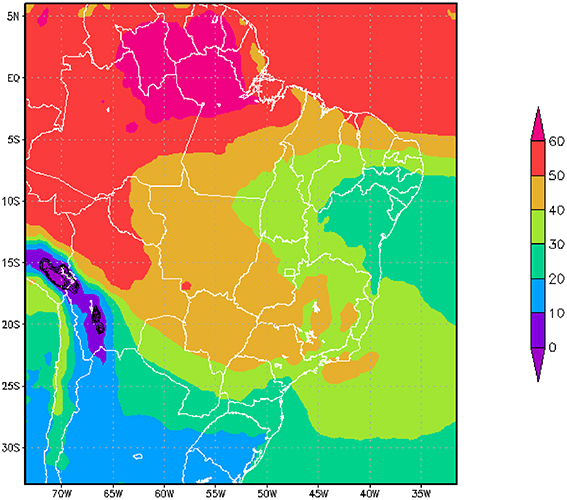
Figure 6. Downward Long Wave Radiation at Surface mean change (W m−2) for the period 2071–2100 relative to the climatological run.
Precipitation Changes
Figures 7–9 show the projected precipitation changes for 2011–2040, 2041–2070, and 2071–2100, respectively. The results show a wider ITCZ that results in an increase on the precipitation over the north coast of South America. This broadening of the ITCZ causes a higher precipitation on the interface between the continent and the tropical Atlantic on the north and northeast of Brazil showing that OLAM is able to represent better the local regional changes in this location due to its better spatial resolution. The increase on the precipitation in this region is also associated with the wind results that show an increase of moisture convergence on the region (Figures 10–12).
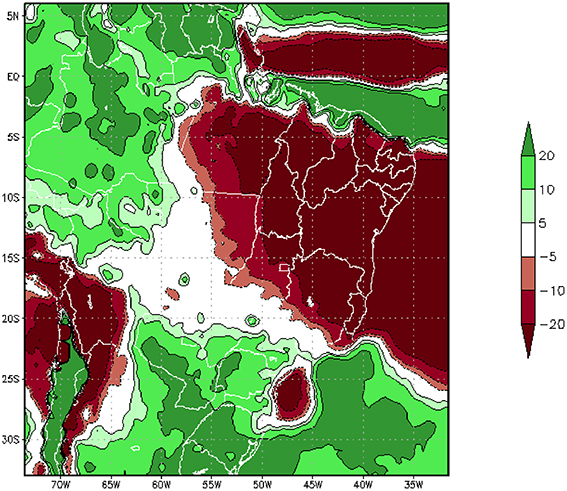
Figure 7. Projected change in precipitation (%) for 2011–2040 relative to the climatological run 1960–1990.
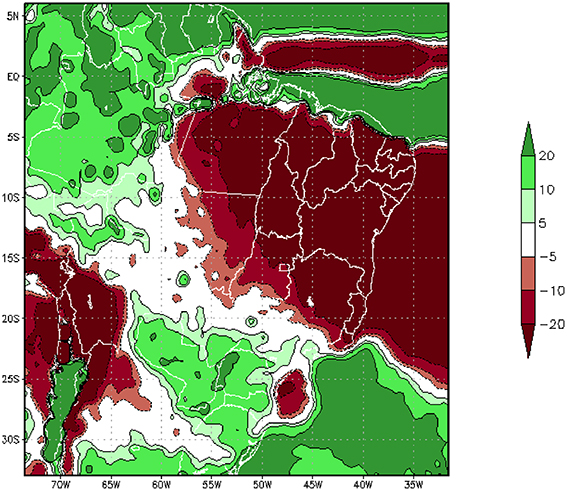
Figure 8. Same as Figure 7, but for precipitation changes (%) on the period 2041-2070.
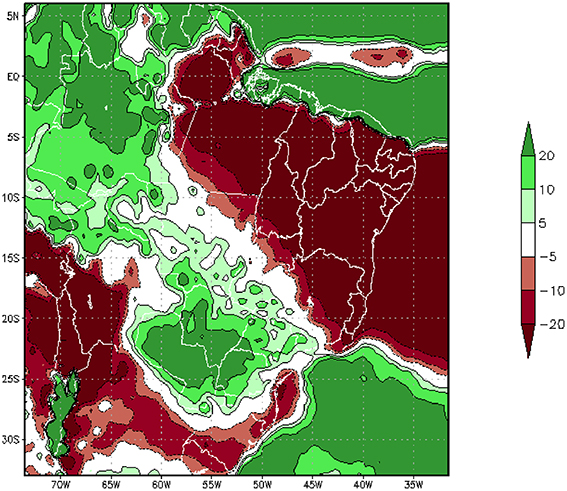
Figure 9. Same as Figure 7, but for precipitation changes (%) on the period 2071–2100.
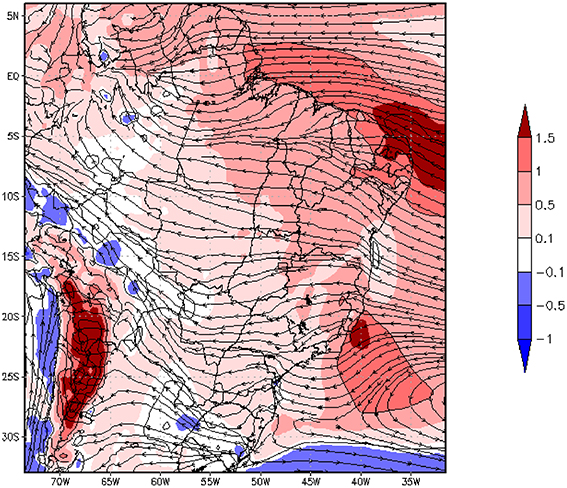
Figure 10. Wind changes (m/s) for the period 2011–2040 relative to the climatological run 1960–1990. The wind currents represent the mean wind field for the period.
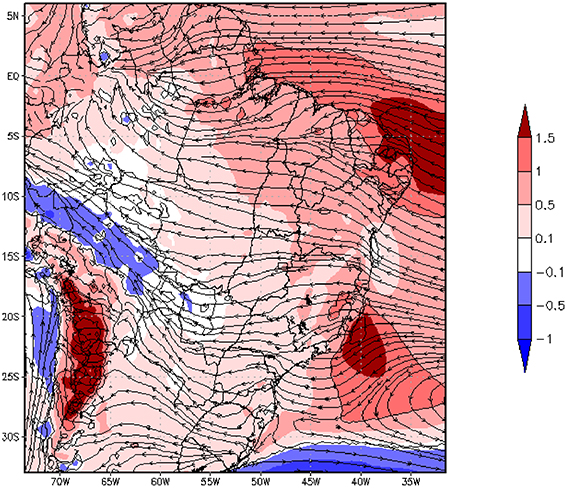
Figure 11. Same as Figure 10 but for the wind changes (m/s) on the period 2041–2070.
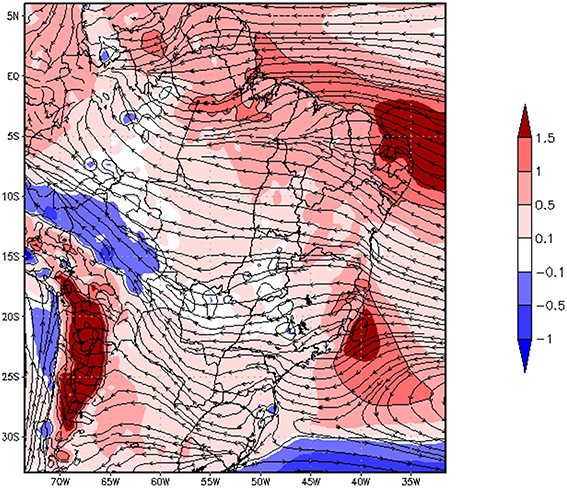
Figure 12. Same as Figure 10, but for the wind changes (m/s) on the period 2071–2100.
Further, analysis show a projected decrease on the precipitation mainly over the northeast region of Brazil and an increase over the west of the Amazon and over the south of the domain. However other regional changes are highlighted on some regions such as on the sea–land interface in the south Brazil where there is a stationary region of precipitation decrease that may be associated with the local ocean warming and with wind pattern changes (Figures 10–12). Recent studies show also regional changes associated with an expansion of the Hadley Cell in response to greenhouse forcing (Fu, 2015; Nguyen et al., 2015, 2013). In the west of the domain, over the Andes Mountains, there is a decrease on the precipitation that seems to be associated with the weakening on the moisture transport from the Amazon region (Figures 10–12). These projected precipitation changes in the South America are similar to the results of the GCMs used on the CMIP project, but can provide important regional features of the local climate that the GCMs can't provide.
Wind Changes
Figures 10–12 show the projected wind changes for 2011–2040, 2041–2070, and 2071–2100, respectively. The results show an overall increase on the wind speed, mainly over the northeast region of Brazil where the winds are from the east. In some regions there is and increase greater than 1.5 m/s. In general the results show that regions of stronger winds can become even stronger. At the continental tropical areas the stronger winds are associated with the moisture convergence produced at the west region of the Amazon where there is an increase on the precipitation. This favors a stronger South Atlantic Convergence Zone (SACZ) that is aligned from the northwest to southeast where there is an increase on the precipitation that extends from the west Amazon to southeast Brazil (Figures 7–9).
Discussion
Unless the regional climate limited area models, the new OLAM model has the capability to represent the large scale interaction with the regional local scale using a refining grid approach. Applied to study the impacts of global ocean warming on the South America climate, it shows a major increase on the temperature over the entire domain mainly over the Amazon region. Changes in the precipitation shows: an increase over the south Brazil and over western Amazon and a decrease over the northeast region of Brazil.
These projected changes in precipitation associated with changes on the convergence zones can impact the position and strength of the main tropical cells such as the Hadley Cell and the Walker Cell. While there is a broadening of the ITCZ associated with the Hadley Cell, the changes on the position of the Walker Cell are responsible for the drier climate over the northeast region.
Similar projections were obtained by the GCMs used on the CMIP project, but OLAM has a higher resolution and therefore it provides a detailed projection for the region. For instance, the model is able to resolve better the sea–land interfaces such as on the north region and the topography on the regions such as over the Andes Mountains. Similar projections were obtained by regional climate models applied for the South America region (Kitoh et al., 2011; Blázquez et al., 2012; Solman, 2013; Chou et al., 2014). However, those RCMs were limited area models and had to perform lateral nudging from other GCMs to produce their projections. OLAM has a new approach because it uses a global icosahedral grid along with a refining regional grid domain, and allows a two-way interaction between the global and local scales. In general, climate projections are obtained with the ensemble of various models. OLAM model adds an important new approach to this ensemble. Due to its capability to represent simultaneously phenomena of various scales, it can provide important improvements on the understanding of the physical processes involved on the regional climate change projections and its interaction with the global changes.
The results obtained with OLAM did not included the greenhouse gases trends on its atmospheric model, however there was a noticeable enhancement on the greenhouse effect caused by the increase of the water vapor. The major results were a response from the ocean global warming. The South America region has a strong influence from the El Niño Southern Oscillation (ENSO) and La Niña events. Therefore, assuming that the Hadley Center model oceanic projections show a higher frequency of ENSO events (Collins, 2000), it is likely that those effects can have a crucial importance for the region's climate. The model results resemble the major findings from recent global and regional climate scenarios for the South America and therefore support the results for the climate projections obtained by the majority of those models for this region.
Author Contributions
RD and RH worked together on the regional climate model setup, integration, and data analysis.
Conflict of Interest Statement
The authors declare that the research was conducted in the absence of any commercial or financial relationships that could be construed as a potential conflict of interest.
Acknowledgments
We thanks to ANEEL and Tractebel Energy for their support on the development of this project.
References
Adler, R. F., Huffman, G. J., Chang, A., Ferraro, R., Xie, P.-P., Janowiak, J., et al. (2003). The Version-2 global precipitation climatology project (GPCP) monthly precipitation analysis (1979–Present). J. Hydrometeorol. 4, 1147–1167. doi: 10.1175/1525-7541(2003)004<1147:TVGPCP>2.0.CO;2
Blázquez, J., Nuñez, M. N., and Kusunoki, S. (2012). Climate projections and uncertainties over south america from mri/jma global model experiments. Atmos. Clim. Sci. 2, 381–400. doi: 10.4236/acs.2012.24034
Bombardi, R. J., and Carvalho, L. M. V. (2011). The South Atlantic dipole and variations in the characteristics of the South American Monsoon in the WCRP-CMIP3 multi-model simulations. Clim. Dyn. 36, 2091–2102. doi: 10.1007/s00382-010-0836-9
Bombardi, R. J., Carvalho, L. M. V., Jones, C., and Reboita, M. S. (2014). Precipitation over eastern South America and the South Atlantic Sea surface temperature during neutral ENSO periods. Clim. Dyn. 42, 1553–1568. doi: 10.1007/s00382-013-1832-7
Chen, C., and Cotton, W. R. (1987). The Physics of the marine stratocumulus-capped mixed layer. J. Atmos. Sci. 44, 2951–2977.
Chou, S. C., Lyra, A., Mourão, C., Dereczynski, C., Pilotto, I., Gomes, J., et al. (2014). Assessment of climate change over South America under RCP 4.5 and 8.5 downscaling scenarios. Am. J. Clim. Chang. 3, 512–525. doi: 10.4236/ajcc.2014.35043
Cohen, J. C. P., Silva Dias, M. A. F., and Nobre, C. A. (1995). Environmental conditions associated with Amazonian squall lines. A case study. Mon. Weather Rev. 123, 3163–3174.
Collins, M., Tett, S. F. B., and Cooper, C. (2001). The internal climate variability of HadCM3, a version of the Hadley Centre coupled model without flux adjustments. Clim. Dyn. 17, 61–81. doi: 10.1007/s003820000094
Collins, M. (2000). The El Nino-Southern Oscillation in the second Hadley Centre coupled model and its response to greenhouse warming. J. Clim. 13, 1299–1312. doi: 10.1175/1520-0442(2000)013<1299:TENOSO>2.0.CO;2
Collins, M., Knutti, R., Arblaster, J., Dufresne, J.-L., Fichefet, T., Friedlingstein, P., et al. (2013). Climate Change 2013 The Physical Science Basis. Long-term Climate Change: Projections, Commitments and Irreversibility, Working. Group. I Contribution to the Fifth Assessment. Report of the Intergovernmental Panel on Climate Change, 1029–1136.
Cotton, W. R., Pielke, R. A. Sr. Walko, R. L., Liston, G. E., Tremback, C. J., Jiang, H., et al. (2003). RAMS 2001: current status and future directions. Meteorol. Atmos. Phys. 82, 5–29. doi: 10.1007/s00703-001-0584-9
Foltz, G. R., Grodsky, S. A., and Carton, J. A. (2003). Seasonal mixed layer heat budget of the tropical Atlantic Ocean. J. Geophys. Res. 108, 1–13. doi: 10.1029/2002jc001584
Freitas, S. R., Silva Dias, M. A. F., Silva Dias, P. L., Longo, K. M., Artaxo, P., Andreae, M. O., et al. (2000). A convective kinematic trajectory technique for low resolution atmospheric models. J. Geophys. Res. 105, 24375–24386. doi: 10.1029/2000JD900217
Fu, R. (2015). Global warming-accelerated drying in the tropics. Proc. Natl. Acad. Sci. U.S.A. 112, 3593–3594. doi: 10.1073/pnas.1503231112
Gandu, A. W., Cohen, J. C. P., and de Souza, J. R. S. (2004). Simulation of deforestation in eastern Amazonia using a high-resolution model. Theor. Appl. Climatol. 78, 123–135. doi: 10.1007/s00704-004-0048-5
Giorgi, F., and Gutowski, W. J. Jr. (2015). Regional dynamical downscaling and the CORDEX initiative. Annu. Rev. Environ. Resour. 40, 467–490. doi: 10.1146/annurev-environ-102014-021217
Gonçalves, F. L. T., Martins, J. A., Albrecht, R. I., Morales, C. A., Silva Dias, M. A., and Morris, C. E. (2012). Effect of bacterial ice nuclei on the frequency and intensity of lightning activity inferred by the BRAMS model. Atmos. Chem. Phys. 12, 5677–5689. doi: 10.5194/acp-12-5677-2012
Gordon, C., Cooper, C., Senior, C. A., Banks, H., Gregory, J. M., Johns, C., et al. (2000). The simulation of SST, sea ice extents and ocean heat transports in a version of the Hadley Centre coupled model without flux adjustments. Clim. Dyn. 16, 147–168. doi: 10.1007/s003820050010
Grell, G. A. (1993). Prognostic evaluation of assumptions used by cumulus parameterizations. Mon. Weather Rev. 121, 764–787.
Grell, G. A. (2002). A generalized approach to parameterizing convection combining ensemble and data assimilation techniques. Geophys. Res. Lett. 29, 1693. doi: 10.1029/2002GL015311
Grimm, A. M. (2003). The El Nino impact on the summer monsoon in Brazil: regional processes versus remote influences. J. Clim. 16, 263–280. doi: 10.1175/1520-0442(2003)016<0263:TENIOT>2.0.CO;2
IPCC (2007). Climate Change 2007 - The Physical Science Basis. Working Group I Contribution to the Fourth Assessment Report of the IPCC.
IPCC (2013). Climate Change 2013: The Physical Science Basis. Contribution of Working Group I to the Fifth Assessment Report of the Intergovernmental Panel on Climate Change.
Kain, J. S. (2004). The Kain–Fritsch convective parameterization: an update. J. Appl. Meteorol. 43, 170–181. doi: 10.1175/1520-0450(2004)043<0170:TKCPAU>2.0.CO;2
Kanamitsu, M., Ebisuzaki, W., Woollen, J., Yang, S.-K., Hnilo, J. J., Fiorino, M., et al. (2002). NCEP–DOE AMIP-II Reanalysis (R-2). Bull. Am. Meteorol. Soc. 83, 1631–1643. doi: 10.1175/BAMS-83-11-1631
Kirtman, B., Power, S. B., Adedoyin, J. A., Boer, G. J., Bojariu, R., and Camilloni, I. (2013). “Near-term climate change: projections and predictability,” in Climate Change 2013 - The Physical Science Basis, ed Intergovernmental Panel on Climate Change (Cambridge: Cambridge University Press), 953–1028.
Kitoh, A., Kusunoki, S., and Nakaegawa, T. (2011). Climate change projections over South America in the late 21st century with the 20 and 60 km mesh Meteorological Research Institute atmospheric general circulation model (MRI-AGCM). J. Geophys. Res. 116, D06105. doi: 10.1029/2010jd014920
Kucharski, F., Polzin, D., and Hastenrath, S. (2008). Teleconnection mechanisms of northeast Brazil droughts : modeling and empirical evidence. Rev. Bras. Meteorol. 23, 115–125. doi: 10.1590/S0102-77862008000200001
Lindzen, R. S., and Nigam, S. (1987). On the role of sea-surface temperature-gradients in forcing low level winds and convergence in the tropics. J. Atmos. Sci. 44, 2418–2436.
Longo, K. M., Freitas, S. R., Pirre, M., Marécal, V., Rodrigues, L. F., Panetta, J., et al. (2013). The chemistry CATT BRAMS model (CCATT BRAMS 4.5): a regional atmospheric model system for integrated air quality and weather forecasting and research. Geosci. Model Dev. 6, 1389–1405. doi: 10.5194/gmd-6-1389-2013
Marengo, J. A., and Hastenrath, S. (1993). Case studies of extreme climatic events in the Amazon Basin. J. Clim. 6, 617–627.
Marengo, J. A., Chou, S. C., Kay, G., Alves, L. M., Pesquero, J. F., Soares, W. R., et al. (2012). Development of regional future climate change scenarios in South America using the Eta CPTEC/HadCM3 climate change projections: climatology and regional analyses for the Amazon, São Francisco and the Paraná River basins. Clim. Dyn. 38, 1829–1848. doi: 10.1007/s00382-011-1155-5
Medvigy, D., Walko, R. L., Otte, M. J., and Avissar, R. (2010). The ocean–land–atmosphere model: optimization and evaluation of simulated radiative fluxes and precipitation. Mon. Weather Rev. 138, 1923–1939. doi: 10.1175/2009MWR3131.1
Medvigy, D., Walko, R. L., and Avissar, R. (2012). Simulated links between deforestation and extreme cold events in South America. J. Clim. 25, 3851–3866. doi: 10.1175/JCLI-D-11-00259.1
Meyers, M. P., Walko, R. L., Harrington, J. Y., and Cotton, W. R. (1997). New RAMS cloud microphysics parameterization. Part II: the two-moment scheme. Atmos. Res. 45, 3–39.
Nguyen, H., Evans, A., Lucas, C., Smith, I., and Timbal, B. (2013). The Hadley circulation in reanalyses: climatology, variability, and change. J. Clim. 26, 3357–3376. doi: 10.1175/JCLI-D-12-00224.1
Nguyen, H., Lucas, C., Evans, A., Timbal, B., and Hanson, L. (2015). Expansion of the Southern Hemisphere Hadley Cell in response to greenhouse gas forcing. J. Clim., 28, 8067–8077. doi: 10.1175/JCLI-D-15-0139.1
Nobre, P., and Shukla, J. (1996). Variations of sea surface temperature, wind stress, and rainfall over the Tropical Atlantic and South America. J. Clim. 9, 2464–2479.
Ramos da Silva, R., Mota, M. A., Cohen, J. C. P., and Gandu, A. W. (2007). Progressos na Detecção e Previsão de Eventos Meteorológicos Extremos na Amazônia Oriental. Boletim Soc. Brasil. Meteorol. SBMET 31, 12–19.
Ramos da Silva, R., Werth, D., and Avissar, R. (2008). Regional impacts of future land-cover changes on the Amazon Basin wet-season climate. J. Clim. 21, 1153–1170. doi: 10.1175/2007JCLI1304.1
Ramos-da-Silva, R., Gandú, A. W., Cohen, J. C., Kuhn, P., and Mota, M. A. (2014). Weather forecasting for Eastern Amazon with OLAM model. Rev. Bras. Meteorol. 29, 11–22. doi: 10.1590/0102-778620130026
Rao, V. B., Giarolla, E., Kayano, M. T., and Franchito, S. H. (2006). Is the recent increasing trend of rainfall over northeast Brazil related to sub-Saharan drought? J. Clim. 19, 4448–4453. doi: 10.1175/JCLI3862.1
Ropelewski, C. F., and Halpert, M. S. (1987). Global and regional scale precipitation patterns associated with the El Niño/Southern oscillation. Mon. Weather Rev. 115, 1606–1626.
Servain, J., Caniaux, G., Kouadio, Y. K., McPhaden, M. J., and Araujo, M. (2014). Recent climatic trends in the tropical Atlantic. Clim. Dyn. 43, 3071–3089. doi: 10.1007/s00382-014-2168-7
Smagorinsky, J. (1963). General circulation experiments wiht the primitive equations I. The basic experiment. Mon. Weather Rev. 91, 99–164.
Solman, S. A. (2013). Regional climate modeling over south america : a review. Adv. Meteorol. 2013:504357. doi: 10.1155/2013/504357
Taylor, K. E., Willianson, D., and Zwiers, F. (2000). The Sea Surface Temperature and Sea-Ice Concentration Boundary Conditions For Amip II Simulations. Livermore: University of California, Lawrence Livermore National Laboratory.
Taylor, K. E., Stouffer, R. J., and Meehl, G. A. (2012). An overview of CMIP5 and the experiment design. Bull. Am. Meteorol. Soc. 93, 485–498. doi: 10.1175/BAMS-D-11-00094.1
Walko, R. L., and Avissar, R. (2008a). The ocean–land–atmosphere model (olam). Part I: shallow-water tests. Mon. Weather Rev. 136, 4033–4044. doi: 10.1175/2008MWR2522.1
Walko, R. L., and Avissar, R. (2008b). The Ocean–Land–Atmosphere Model (OLAM). Part II: formulation and tests of the nonhydrostatic dynamic core. Mon. Weather Rev. 136, 4045–4062. doi: 10.1175/2008MWR2523.1
Walko, R. L. W. R, Cotton, M. P., Meyers, M. P., and and, Harrington, J. Y. (1995). New RAMS cloud microphysics parameterization Part I: the single-moment scheme. Atmos. Res. 38, 29–62. doi: 10.1016/0169-8095(94)00087-T
Walko, R. L., Cotton, W. R., Feingold, G., and Stevens, B. (2000b). Efficient computation of vapor and heat diffusion between hydrometeors in a numerical model. Atmos. Res. 53, 171–183. doi: 10.1016/S0169-8095(99)00044-7
Walko, R. L., Band, L. E., Baron, J., Kittel, T. G. F., Lammers, R., Lee, T. J., et al. (2000a). Couple atmosphere-biophysics-hydrology models for environmental modeling. J. Appl. Meteorol. Soc. 39, 931–944. doi: 10.1175/1520-0450(2000)039<0931:CABHMF>2.0.CO;2
Wang, C. Z. (2002). Atlantic climate variability and its associated atmospheric circulation cells. J. Clim. 15, 1516–1536. doi: 10.1175/1520-0442(2002)015<1516:ACVAIA>2.0.CO;2
Keywords: OLAM, regional climate modeling, climate change, South America, Brazil
Citation: Ramos da Silva R and Haas R (2016) Ocean Global Warming Impacts on the South America Climate. Front. Earth Sci. 4:30. doi: 10.3389/feart.2016.00030
Received: 15 October 2015; Accepted: 08 March 2016;
Published: 29 March 2016.
Edited by:
David Mendes, Federal University of Rio Grande do Norte, BrazilReviewed by:
Beate G. Liepert, NorthWest Research Associates, USAMarcio Machado Cintra, Universidade Federal do Rio Grande do Norte, Brazil
Copyright © 2016 Ramos da Silva and Haas. This is an open-access article distributed under the terms of the Creative Commons Attribution License (CC BY). The use, distribution or reproduction in other forums is permitted, provided the original author(s) or licensor are credited and that the original publication in this journal is cited, in accordance with accepted academic practice. No use, distribution or reproduction is permitted which does not comply with these terms.
*Correspondence: Renato Ramos da Silva, renato.ramos@ufsc.br
 Renato Ramos da Silva
Renato Ramos da Silva Reinaldo Haas
Reinaldo Haas